Set along the coast in Vietnam, the historical centres of Hoi An and Hue offer a unique look into Vietnam’s past. From its ties to the spice trade to the Imperial City, this is a fascinating part of Vietnam.
Hoi An was once one of the most important trading posts in the spice trade. It’s located on the coast in a large estuary of the Thu Bồn River. As early as the 15th century Hoi An was trading with merchant ships from China, Portugal, Holland and India. Its Old Town’s streets and buildings reflect the influences from this multi-cultural past. This UNESCO World Heritage site, Old Town is now mostly a pedestrian-only area making it a very pleasant area to wander around on foot. The tree-lined streets are bordered by bright, low roofed buildings and decorated with Chinese lanterns. The restored buildings are shops, restaurants and many are family homes, still lived in today.

Old Town, Hoi An 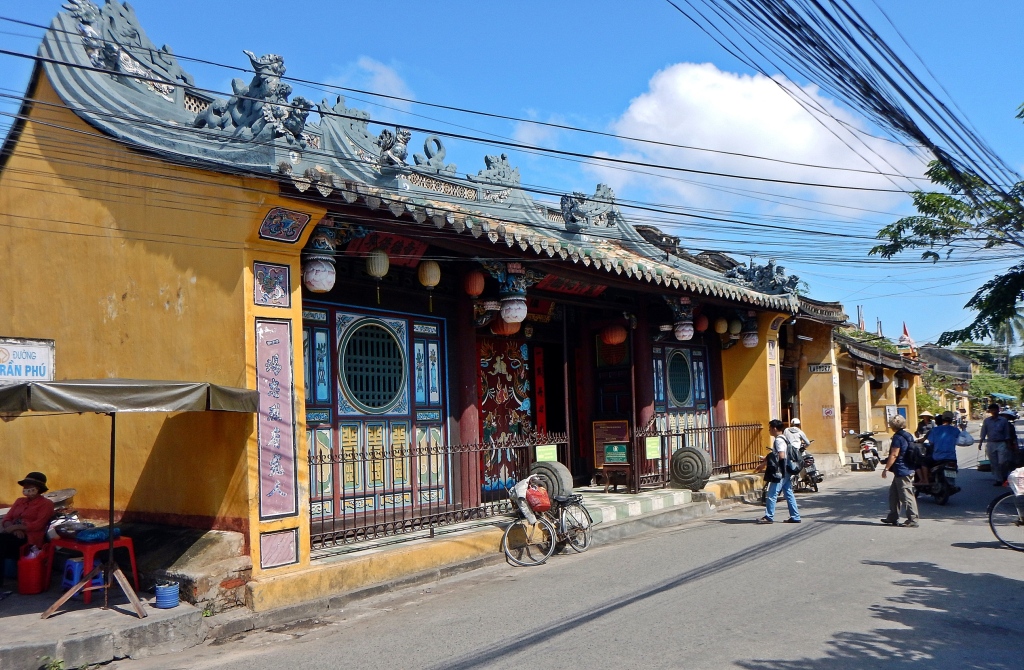
Old Town, Hoi An 
Old Town, Hoi An 
Old Town, Hoi An 
Gas station, Hoi An
Old Town also has many old temples for Confucianism, Taoism and Buddhism. The architecture and interior design of these temples is very charming. They are brightly painted buildings with low terracotta roofs decorated with dragons or gargoyles and turned up at the corners. Inside are bright paintings, golden vases and colourful columns.

Temple, Hoi An 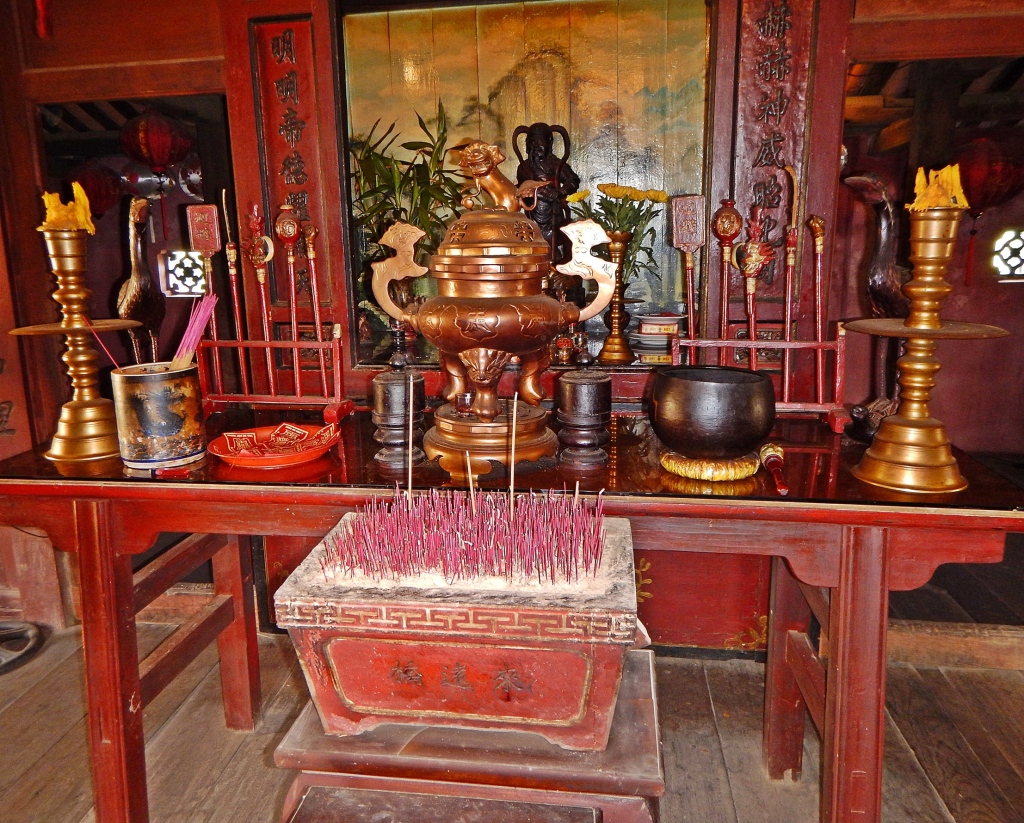
Temple interior, Hoi An 
Temple, Hoi An 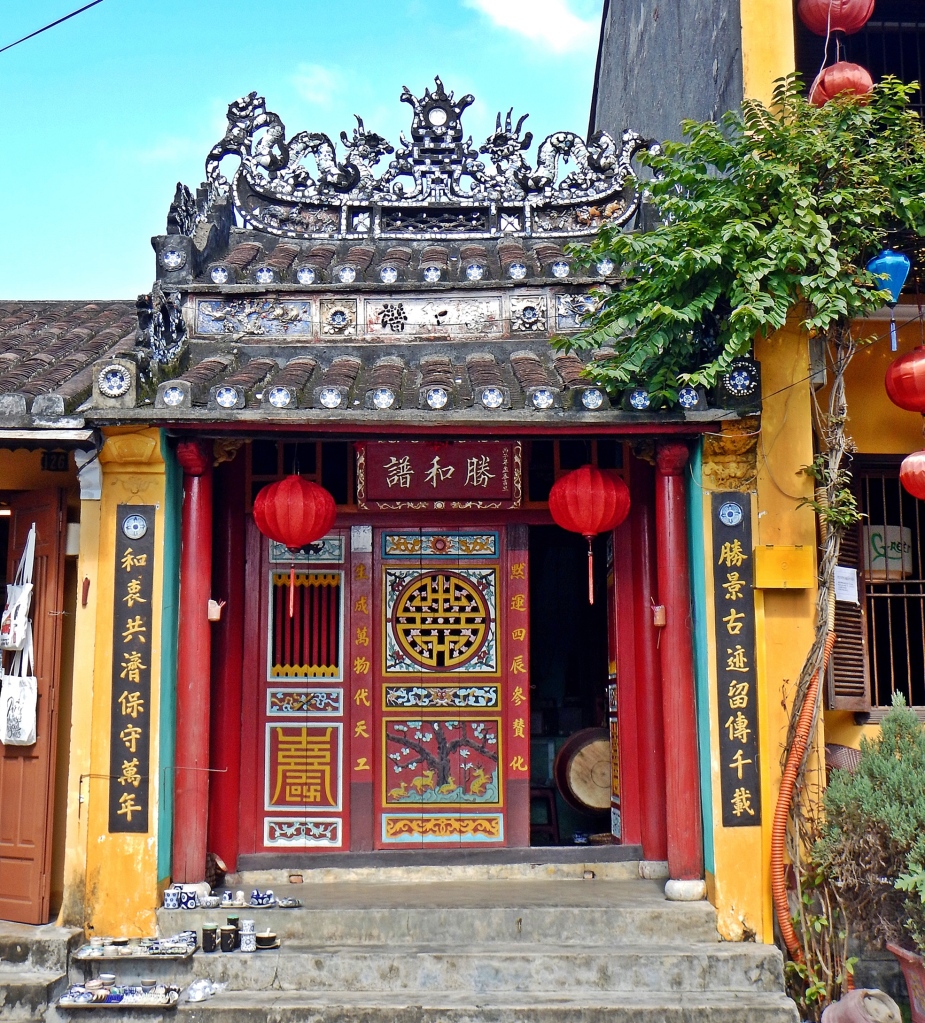
Temple, Hoi An 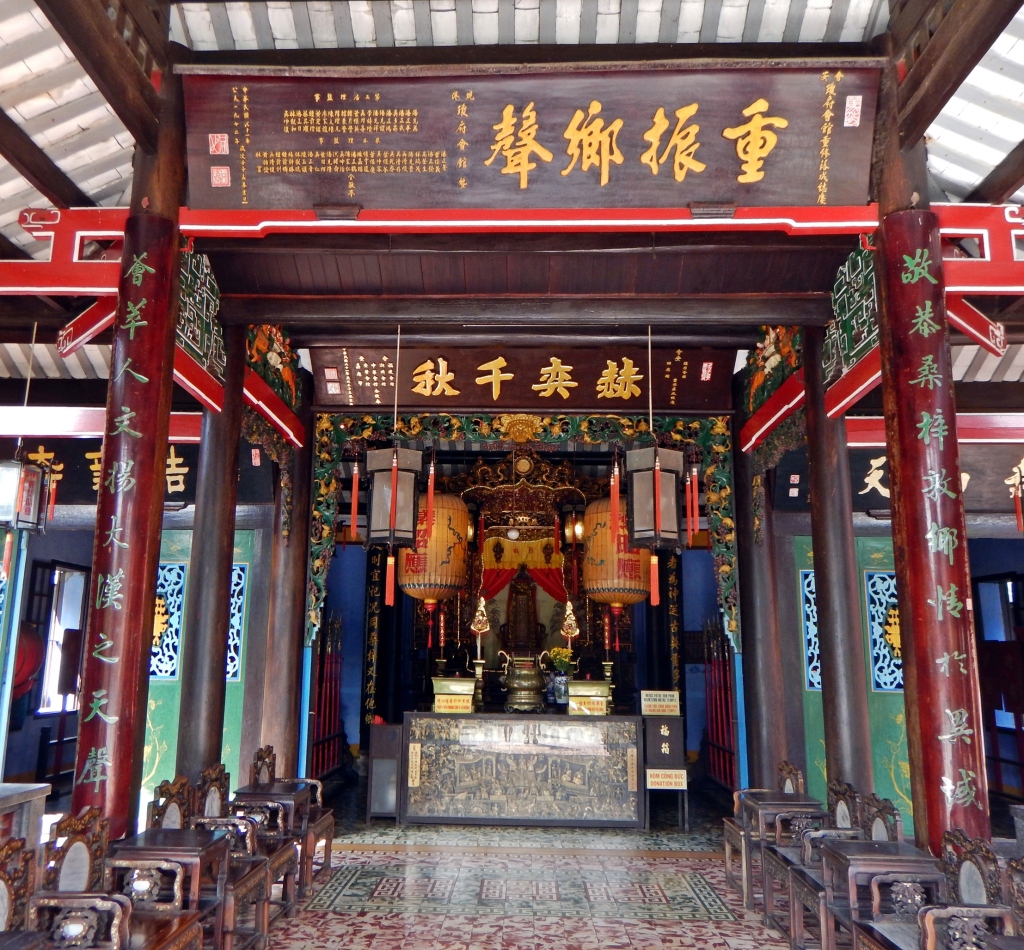
Temple interior, Hoi An
One of the most popular sites in Hoi An is the 16th century Japanese bridge. It’s a gorgeous old stone bridge with a wooden cover. The decorated roof, curved shape and stone arches make it a photographer’s dream.

Japanese Bridge, Hoi An
The old trading port has been replaced by a tourist port. Instead of trade boats, the shore is lined with wooden canoes offering boat rides on the Thu Bồn River. Tiny, local women paddle the canoes as tourists enjoy a view of the shore, passing local homes and docked boats. We felt so guilty that we were so large compared to our tiny paddler that we slipped her extra money without her boss noticing. She deserved it. She took us by her house where she said she had a new baby. We’re not sure if it was her baby or her grandchild, but we could see people waving to us from in front of the house. She was very proud to show us her family.

Hoi An waterfront 
Thu Bồn Estuary, Hoi An 
Boat ride, Hoi An 
Waterfront, Hoi An 
Boat ride, Hoi An 
Thu Bồn estuary, Hoi An 
Thu Bồn Estuary, Hoi An
There are quite a few museums in Hoi An, most are small museums held inside families’ historical homes. We went to one where you can see how people lived here centuries ago. The most memorable part was the hard, wooden bed and even harder looking pillow. Hoi An’s Old Town is built on low ground and is very prone to flooding during monsoon season. There was a mark on the museum wall indicated how high the flood waters have been over the years. Some marks were near shoulder height and one of those was dated within the last few years.

Old Town, Hoi An 
Vietnamese bed and pillow, Hoi An
The best beach around is An Bang. On our short bike ride to the beach, we passed rice paddies and green fields. Men and women were working hard in the fields by hand or with buffalo. The beach is a beautiful spot with golden sand and a gentle surf. There are many restaurants and shops where you can rent a sun bed with umbrella; free if you buy lunch or snacks. We were told it would be crowded, but even during peak season, it was fairly quiet.

An Bang beach, Hoi An 
Farmer on a rice paddy, Hoi An 
Farmer, Hoi An 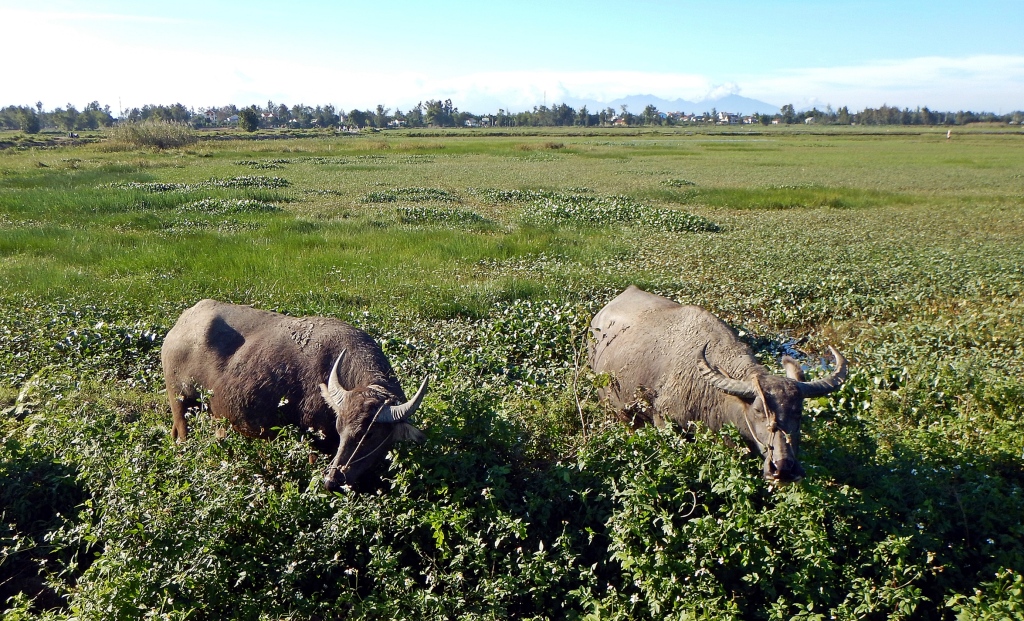
Water buffalo, Hoi An
The food in Hoi An reflects its multicultural history. Meals are often rice, noodles, soup or dumplings but the combined flavours of turmeric, mustard leaves, peanuts, lemongrass, mint and hot chili peppers make them uniquely Hoi An.

Street food, Hoi An 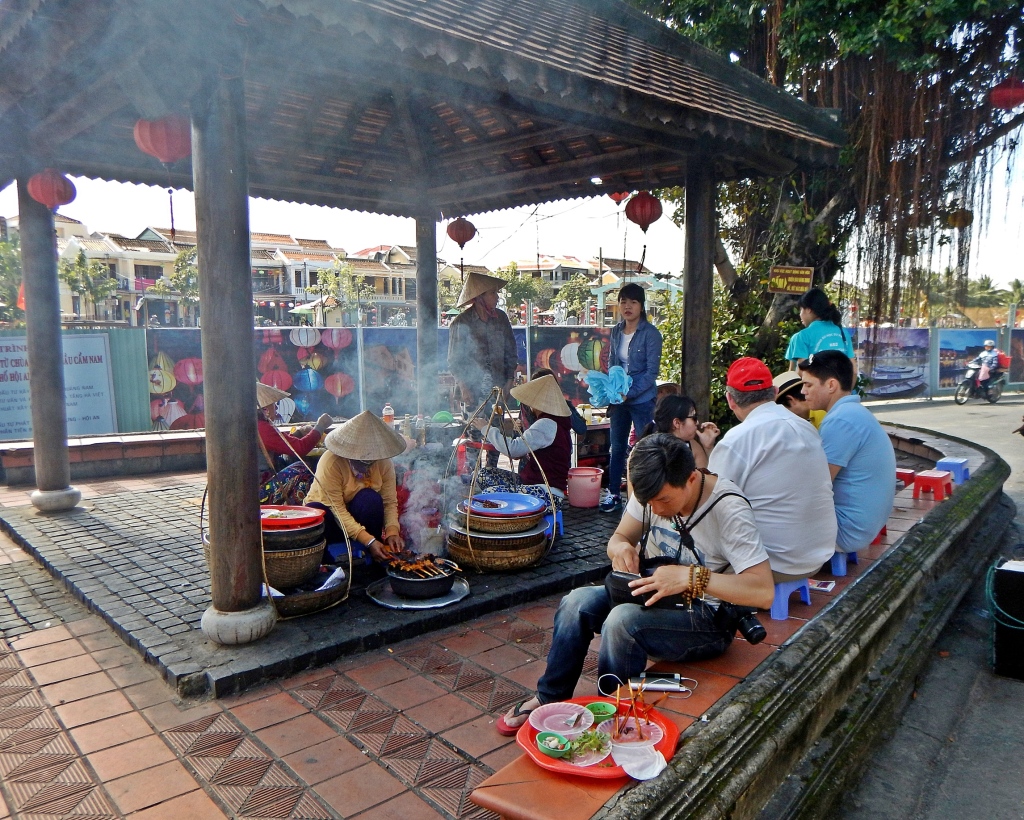
Street food, Hoi An
Getting to Hoi An – There is no airport or train station in Hoi An. The only way to get to Hoi An is by road. The nearby city of Da Nang has an airport, train and bus stations. From Da Nang, hire a taxi to Hoi An.
Tickets – Old City requires tickets for general entry as well as access to several museums and sites. Ticket booths are located at one of the many entrances. Tickets are 120,000 VND per person which includes general entrance and admission to five sightseeing sites. You can purchase additional tickets if you use up the five.
One hundred and twenty km north of Hoi An is the former Vietnamese capital, Hue. Emperor Nguyen made it the capital when he unified Vietnam in the 18th century. The capital was moved to Hanoi in 1945, when the emperor abdicated to the DRV government. The Citadel complex in Hue housed government buildings in the Imperial City and the emperor’s home in the Forbidden Purple City. The complex is surrounded by a tall, stone wall and a large moat. A lot of the buildings were damaged in the Vietnam war, especially those in the Forbidden Purple City. Even though many structures were damaged, there is still a lot to see. You can walk through much of the vast complex where there are dozens of colourful gates with vaulted, arched entrances.
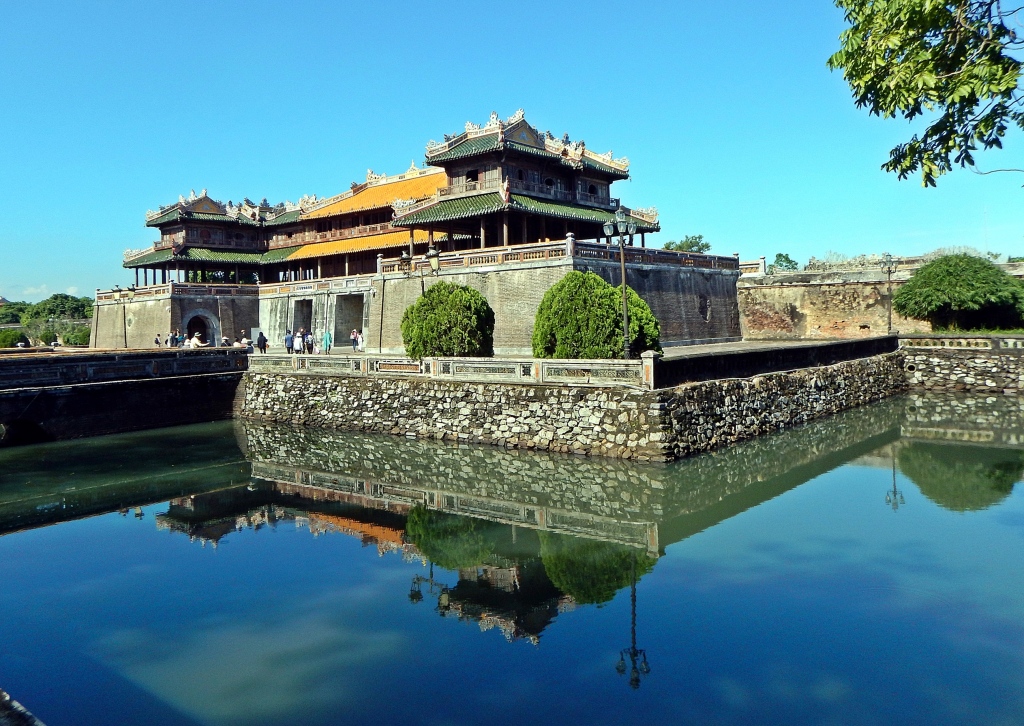
Moat at South Gate, the Citadel, Hue 
The wall, the Citadel, Hue 
Gate in the Citadel, Hue 
Gate in the Citadel, Hue 
The Citadel, Hue 
East Gate, the Citadel, Hue 
Lotus pond, the Citadel, Hue
The stone buildings of the Imperial City have beautiful marble windows and low, terracotta roofs decorated with dragons. Inside many of the buildings have golden decorations and bright wooden shutters. One of our favourite pictures is of a row of nine tripod cauldrons which were built to honour the first emperors of the Nguyen dynasty.
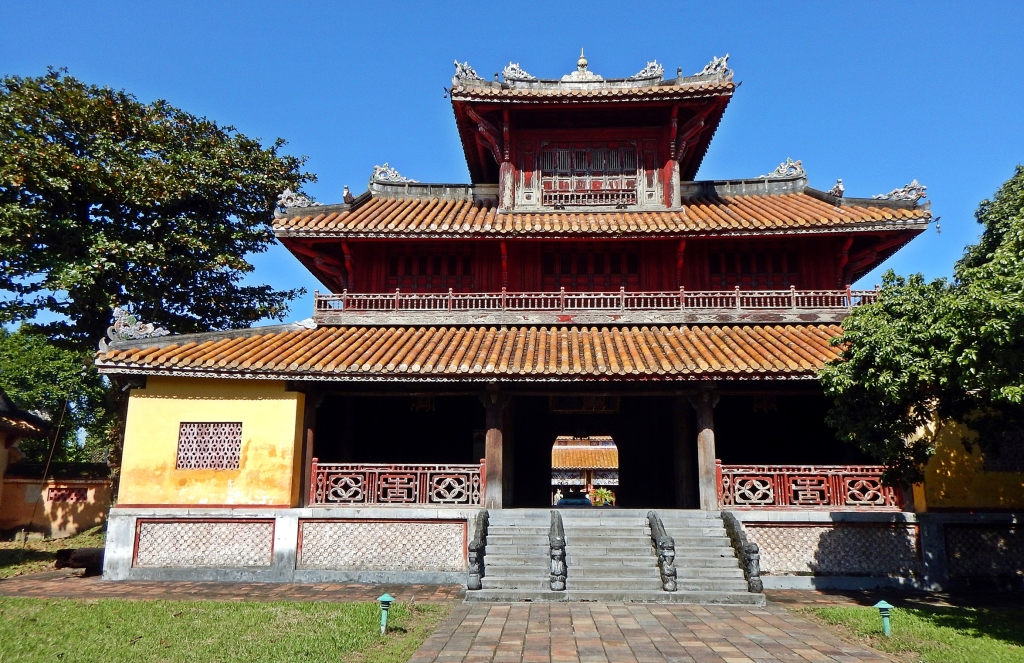
The Citadel, Hue 
The Citadel, Hue 
The Citadel, Hue 
Window, The Citadel, Hue 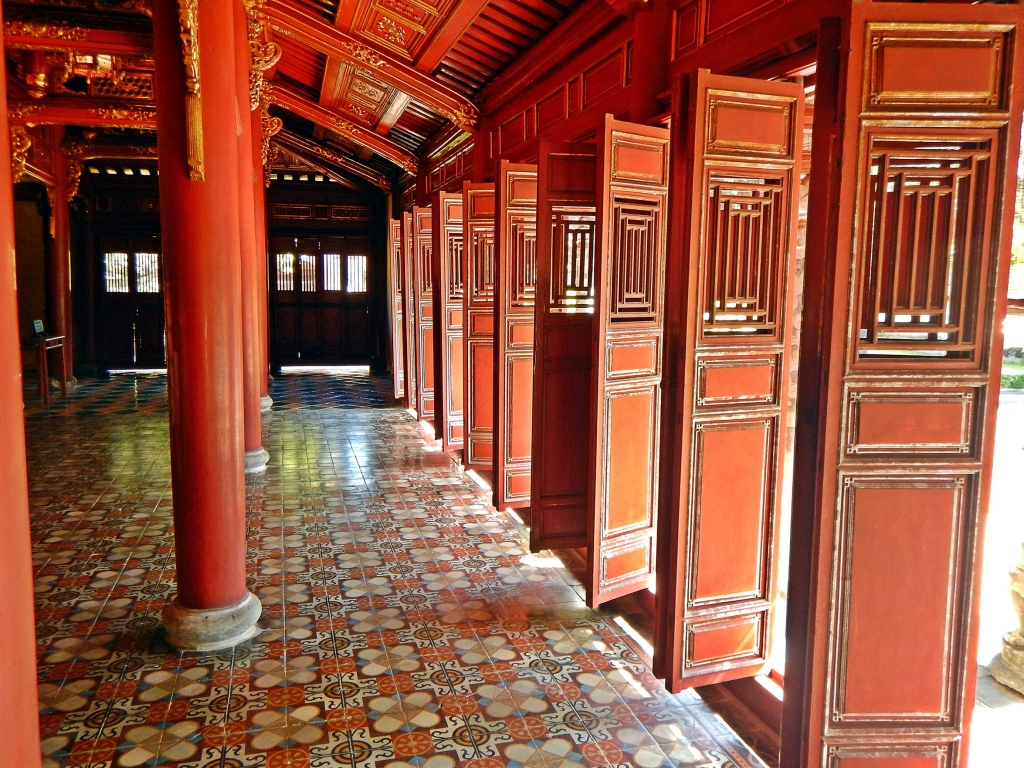
Wooden shutters, The Citadel, Hue 
The Citadel, Hue 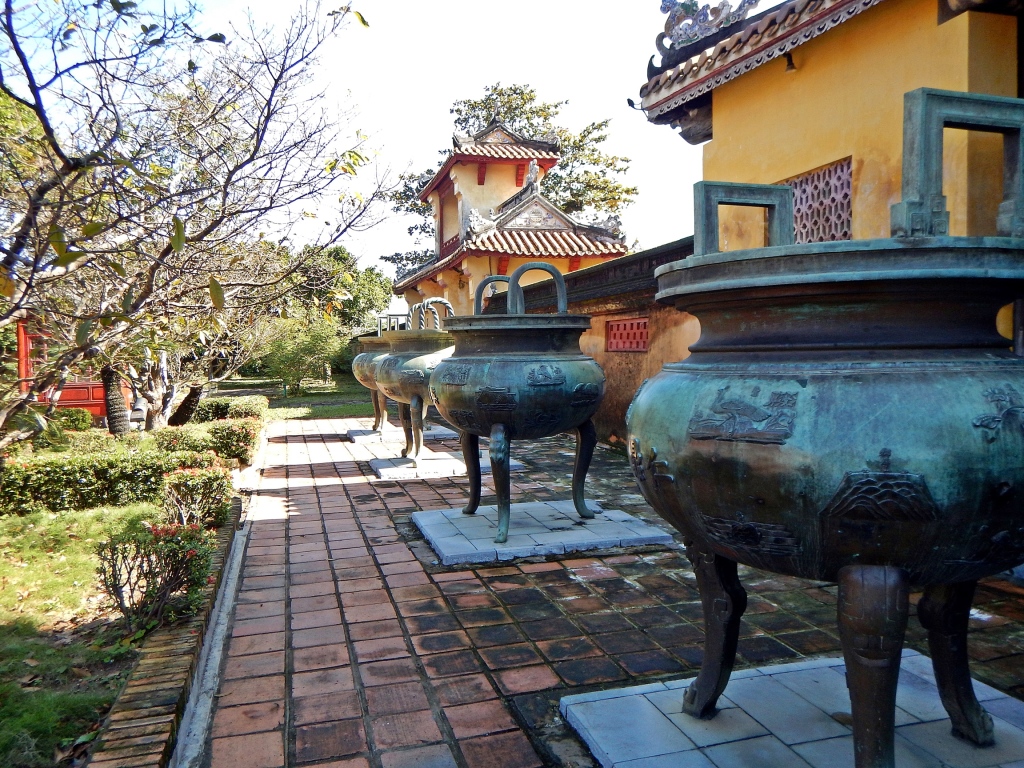
Tripod cauldrons, The Citadel, Hue
There are seven elaborate emperor tombs in the Hue region. The tomb of Emperor Khai Dinh, built in the 1920s, is one of the most ornate. To enter the tomb, first there is a tall stone staircase covered in carvings of dragons and mythical beings. At the top of the stairs are 12 life size statues of guards and two horses, followed by another decorated stone staircase. Inside the tomb, the walls are extravagantly decorated with porcelain, gold and glass designs. It’s very stunning.
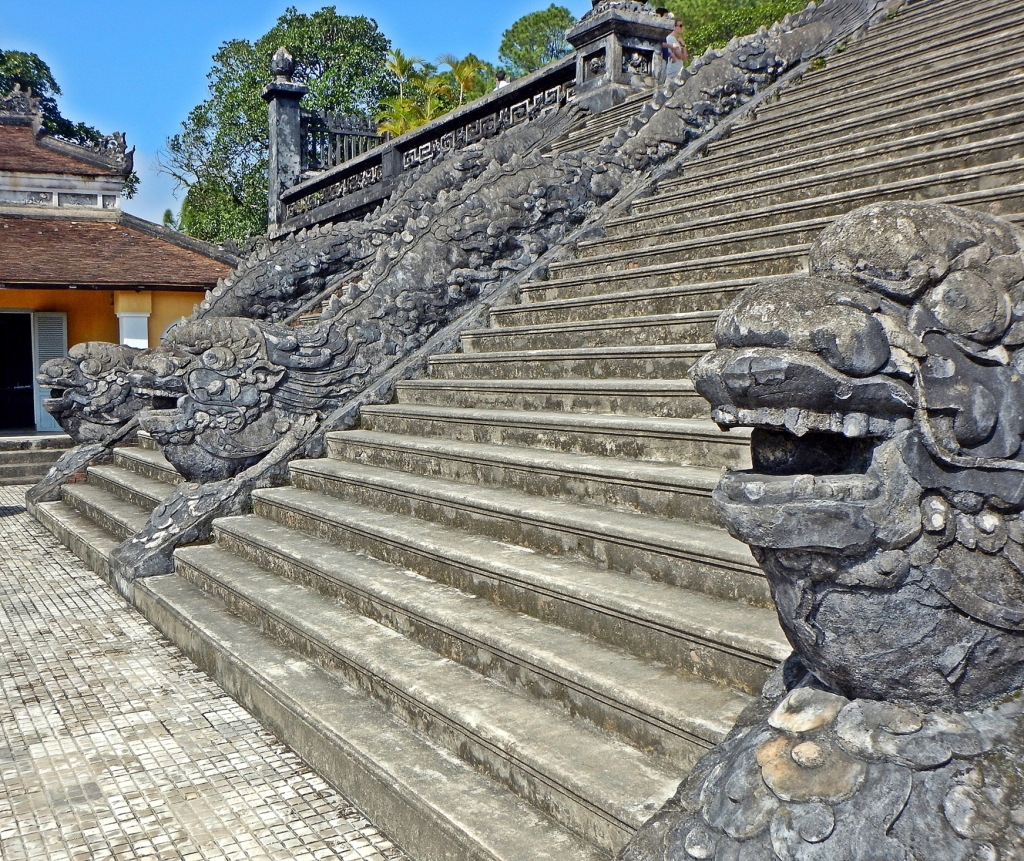
Tomb of Emperor Khai Dinh, Hue 
Guards outside the Tomb of Emperor Khai Dinh, Hue 
Guards outside the Tomb of Emperor Khai Dinh, Hue 
Tomb of Emperor Khai Dinh, Hue 
Interior of the tomb of Emperor Khai Dinh, Hue
Getting to Hue – Hue has a train station and an international airport with limited flights, and is two hours from the larger Da Nang Airport. Or do as we did and hire a taxi for the day from Hoi An. One full day is long enough to see the sites in Hue.
Tickets – Entry tickets to the Citadel are sold at South Gate and are 150,000 VND per person. Entry fee to each tomb is between 40,000 and 100,000 VND per person.
Coming up: Cai Rang Floating Market
For more pictures go to Gallery at Monkey’s Tale.
For more stories from our other adventures, go to Destinations.
If you like what you read, please comment or share (with credit) using the links below.
Lovely overview. We just had four days in Hoi An.
LikeLiked by 2 people
Thank you, it’s a great town isn’t it!
LikeLiked by 1 person
Beautiful post
Thank you for sharing
LikeLiked by 3 people
Thank you for reading!
LikeLike
Had my flight to another destination not been cancelled by the airline, I wouldn’t have gone to Central Vietnam back in April 2017. It was my Plan B, but oh my, what a perfect Plan B it certainly was. My friend and I stayed in Da Nang, Hue and Hoi An, and we loved each of them for different reasons. The Cham museum’s collection in Da Nang was impressive, the palace and the royal tombs in Hue were exquisite, and the old town of Hoi An was charming. Oh, and the food! I love how the Vietnamese combine juicy meat with fresh vegetables and herbs — it makes me feel less guilty devouring those grilled goodness.
LikeLiked by 2 people
A great plan B! This part of Vietnam is still one of our favourite spots. We only went tot Da Nang airport so missed. Thanks for sharing your experience!
LikeLiked by 1 person
Beautiful!
LikeLiked by 2 people
Thank you!
LikeLiked by 1 person
Gorgeous photos! and so many familiar sites, Hoi An was my favourite place I visited in Vietnam and loved exploring the Imperial city in Hue
LikeLiked by 3 people
Thank you, we love Hoi An too!!
LikeLike
Fabulous photos, these places are remarkable, so can’t wait to see them for ourselves next year
LikeLiked by 2 people
You’ll love Hoi An!
LikeLike
that’s great, if you come back Viet Nam , let me help you to show the beautiful another places in Viet Nam
LikeLiked by 1 person
Ok thanks for the offer!!
LikeLike
Beautiful photos. Refreshes memory from 2001 Thanks
LikeLiked by 1 person
You’re welcome! Thanks for reading!!
LikeLiked by 1 person
We’re just planning a trip to Vietnam, so you’ve made me very excited!
LikeLiked by 1 person
Hoi An is my favourite place in Vietnam so don’t miss it. We also loved Halong Bay so consider seeing it too. Have a great trip!
LikeLike
Hoi An and Hue both look beautiful. Hoi An seems to be much loved by visitors, so I’m glad it retains its magic and good to hear that it was your favourite place. Hopefully I’ll get there. I’d be curious to see how it compares to other SE Asian darlings like Luang Prabang or Ubud.
LikeLiked by 1 person
It’s special because people actually live there in their ancestral homes. Even though there are a lot of westerners, the people haven’t changed their ways much. Luang Probang, although beautiful, didn’t feel like a Laotian area and Ubud is so spread out that we didn’t find the same feel as in Hoi An, or maybe we didn’t go to the right area in Ubud.
LikeLiked by 1 person
I really want to visit Vietnam and Cambodia. Thank you for the info
LikeLiked by 1 person
They are great countries to visit. They’re tourist friendly, but have kept their own culture (except for Siem Reap!). Thanks for reading!
LikeLike
Hue is definitely on our list for a return trip to Vietnam! I’m happy to see that Hoi An and An Bang Beach look just as charming as when we visited in 2011. 🙂
LikeLiked by 1 person
Yes it’s definitely one of our favourite spots in Vietnam.
LikeLiked by 1 person
Just re-visiting your post on this region, looks amazing. We are are finally heading there soon so just started our research again. Great photos, can’t wait to get there
LikeLiked by 1 person
I hope it hasn’t changed much, it’s been almost 9 years since we were there. Hoi An was one of our favourite places in Vietnam. I remember the hotels were very nice for very little money. My one memory of Ho Chi Minh was the crooked cab drivers – more than anywhere else in Vietnam.
LikeLiked by 1 person